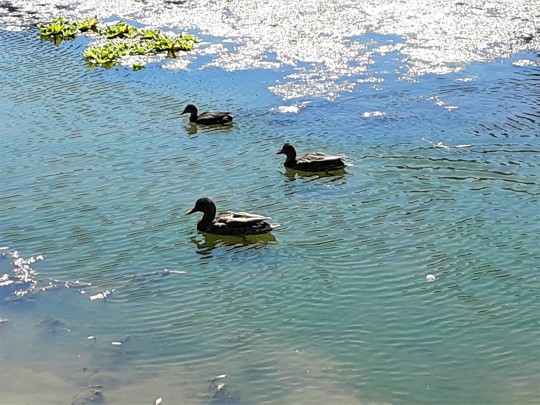Most people assume that ducks are pretty friendly birds. That assumption was not necessarily demonstrated when I was sitting on a bench at a boardwalk in Myrtle Beach, South Carolina, enjoying a double scoop of Ben & Jerry’s with my friend. As we savored our ice cream, a well-deserved treat after practicing rigorously for an orchestra competition, one of the many ducks that spend their days along the boardwalk waddled close to our bench.
Unconcerned, we continued to converse. Soon, the duck was right by my foot, investigating my cone, and I was frozen, unsure about what to do. I nervously continued to eat my ice cream, ignoring my new feathered friend and hoping it would waddle on. That, however, was not the case. After examining my ice cream cone for a couple more seconds, the duck sounded two warning quacks, and then proceeded to grab my pinky finger. My beloved ice cream cone fell to the ground, as I sat shell shocked wondering why this duck had unleashed the wrath of its beak upon me.
My mind was left with one lingering question—why? In my experience, most ducks fly away if a human gets close to them. So why did this duck approach me with its eyes set on my ice cream cone? The answer was in the duck’s environment.
The large flocks of mallard ducks that swarmed that fated boulevard had a single temptation: the fish food dispensers stationed around the area that visitors used to feed the fish in the large pond nearby. As a result, many ducks patrolled the area, hoping to be fed by visitors. The constant contact with humans tamed the mallards; their inherent fear of humans was overridden by the hands that fed them.

Taming, often confused with domestication, is the process of making individual animals comfortable around humans. Domestication, on the other hand, is a process involving multiple generations of selective breeding, to strengthen favored traits.
Mallard ducks, the species of duck that inhabited the boulevard, are very easily tamed through regular feeding. Therefore, the ducks developed a learned behavior, one formed through experience, to approach humans for food. Thus, the duck, most likely familiar with humans feeding it, approached me. Assuming my waffle cone was intended for its stomach, it promptly bit me when I refused.
However, feeding (most) wild animals can be a detriment to their lives. A well-maintained bird feeder in your backyard is okay, as the feed can supplement birds’ diets. However, feeding other wildlife can cause a higher risk of disease transmission, as well as diet problems for wild animals. Feeding wild animals causes them to become more dependent on humans.
Consequently, they may start to hang around areas heavily populated with humans, which can lead to disease transmission and rash behavior towards us.
Moral of the story: don’t feed the ducks junk food, it’ll come back to bite someone else in the pinky.
Samhita Vasudevan is a Teen Volunteer in the Education Department. Museum employees, volunteers, and interns are encouraged to blog about their unique experiences and knowledge gained from working at the museum.
Works Cited
Bittel, Jason. “Why You Shouldn’t Feed Wild Animals (Except Maybe Birds).” National Geographic, National Geographic Partners, 5 July 2019, www.nationalgeographic.com/animals/2019/07/dont-feed-wild-animals-except-birds/. Accessed 15 Aug. 2020.
Brittingham, Margaret C., and Stanley A. Temple. “Does Winter Bird Feeding Promote Dependency?” Searchable Ornithological Research Archive, University of New Mexico, 1991, https://sora.unm.edu/sites/default/files/journals/jfo/v063n02/p0190-p0194.pdf. Accessed 1 October 2020.
“Don’t Feed the Wildlife.” United States Department of Agriculture, 2 June 2020, www.aphis.usda.gov/aphis/ourfocus/wildlifedamage/sa_program_overview/ct_dontfeedw ildlife. Accessed 10 Aug. 2020.
“Learned Behavior of Animals.” LibreTexts, 15 Aug. 2020, bio.libretexts.org/Bookshelves/Introductory_and_General_Biology/Book%3A_Introducto ry_Biology_(CK-12)/10%3A_Animals/10.05%3A_Learned_Behavior_of_Animals. Accessed 16 Aug. 2020.
“Living with Wildlife.” Southwest Wildlife Conservation Center, 2020, www.southwestwildlife.org/resources/living-with-wildlife.html. Accessed 8 Aug. 2020.
“Mallard Duck.” National Wildlife Crime Unit, 2020, www.nwcu.police.uk/animal-of-the-month/mallard-duck/. Accessed 9 Aug. 2020.
Sadedine, Suzanne. “Why Can Some Animals Be Domesticated, but Not Others?” Forbes, Forbes Media, 24 Oct. 2016 www.forbes.com/sites/quora/2016/10/24/why-can-some-animals-be-domesticated-but-no t-others/#68c454de5df4. Accessed 9 Aug. 2020.
